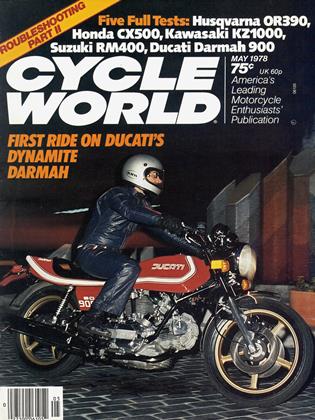ENGINE TROUBLESHOOTING
Part II: Street Bikes A Quick Fix is Better Than a Long Walk
Len Vucci
In our March issue, we provided an out line for effective off-road engine troubleshooting. Its purpose was to aid the ill-fated dirt rider whose machine suffered mechanical maladies at an inopportune time or in a desolate area. By following directions outlined in one of two flow charts, most non-terminal malfunctions can be field repairable, enabling the rider to continue his ride, or at least limp back to his base camp.
Such a situation is by no means limited to the wilderness. Standing beside your new Multi at three in the morning on that little-traveled-at-anytime and thoroughly enjoyable twisty mountain road can be just as desolate.
If you’ve been there you know, if you>!^\V haven’t, you don’t want to know—firsthand, anyway. If you find yourself in such a situation, however, using the basic procedures to be outlined here will be much more effective than kicking, cursing, waiting, or weeping. And if the kiss of logic doesn’t awaken your sleeping beauty, at least you can say you loved and lost.
SCOPE
The application of this piece is fairly comprehensive—if your bike has a license plate, requires a battery for engine operation. and runs on gasoline, this should be a great self-help aid. (Non-battery-ignition bikes such as Honda XLs and Yamaha DTs should refer to our first troubleshooting piece.) This procedure is not meant as a substitute for regular and proper maintenance. Last-ditch measures either out on the road or in the shop won’t counteract a long history of neglect. In this respect the street rider, although he may be as resourceful and conscientious as his dirtriding counterpart, may find himself at a disadvantage. The rigors of serious offroad riding demand periodic maintenance and repair. Either the bike is routinely inspected and kept up or it doesn’t work. A pavement scratches even though it may be depended upon for daily transportation, is more easily abused by neglect. When the strike of silence occurs, it often comes when it’s least expected or appreciated— like when you’re on your way to a job interview and there’s no one around you can call but it wouldn’t matter anyway ’cause you’re all out of dimes, time and luck.
TOOLS REQUIRED
If the majority of your riding is around town, you probably don't carry more than the bike’s OEM tool kit. That’s OK. as long as there’s a friendly service station or someone you can reach by phone to bail you out if the need arises.
If you'll be doing any long-distance touring, however, a few essentials should be on your list and among your gear. Fresh spark plugs and a wrench are items which
you’ll need sooner or later. Why not pick up a set as insurance, and. while you're at it, a few1 spare fuses also. If your bike uses breaker points, as most do, an extra condenser or two can often save your act. In lieu of OEM parts, any automotive condenser can be wired in temporarily.
Wire. A few feet of # 16 or #18 gauge insulated copper and a foot or two of electrician’s tape are easily carried. But if you’re caught w ithout, you can cannibalize a non-essential lead, such as that running to the brakelight. (But your diagnosis had better be correct or you'll have a hard time convincing your local service department that you’re wired properly.)
None of the above will help if you can’t get the points cover off—before you depart make sure it can be removed with tools on hand. Blade and Phillips screwdrivers should be taken along, as should a small pair of Vise-Grips,small adjustable wrench and the previously mentioned plug wrench. These are in addition to the other OEM tools, which should either be of good quality or thrown away and replaced w ith
better items.
If you are fortunate—or unfortunate., depending upon how you see it—enough to break down close to home or somewhere you have access to a more complete tool set, more difficult problems may be analyzed and corrected. For this reason we will include some troubleshooting techniques which would not be possible out on the road. But if the problem is severe enough to require more than hand tools for diagnosis, it will most likely require such tools for repair.
Among the more comprehensive tools which might be required are a volt-ohmmeter for circuit testing, compression gauge for reading cylinder pressure, timing light and/or dial indicator, and vacuum synchronizer for Multis. The one most valuable tool is probably a comprehensive workshop manual, as it elaborates in minute detail the procedures necessary for troubleshooting and repair.
MULTI-FACETED PROBLEMS
A multi-cylindered bike presents several additional problems to the troubleshooter, but also has some distinct advantages. Losing one of four cylinders, for example, still leaves three to limp home on. If the engine won’t run at all. the problem has to be something common to all the cylinders, éliminating other possible ailments. The list goes on. but then that’s the reason for the following charts.
IGNITION TROUBLE SHOOTING CHART
CARBURETION TROU BLESHOOTING CHART


















